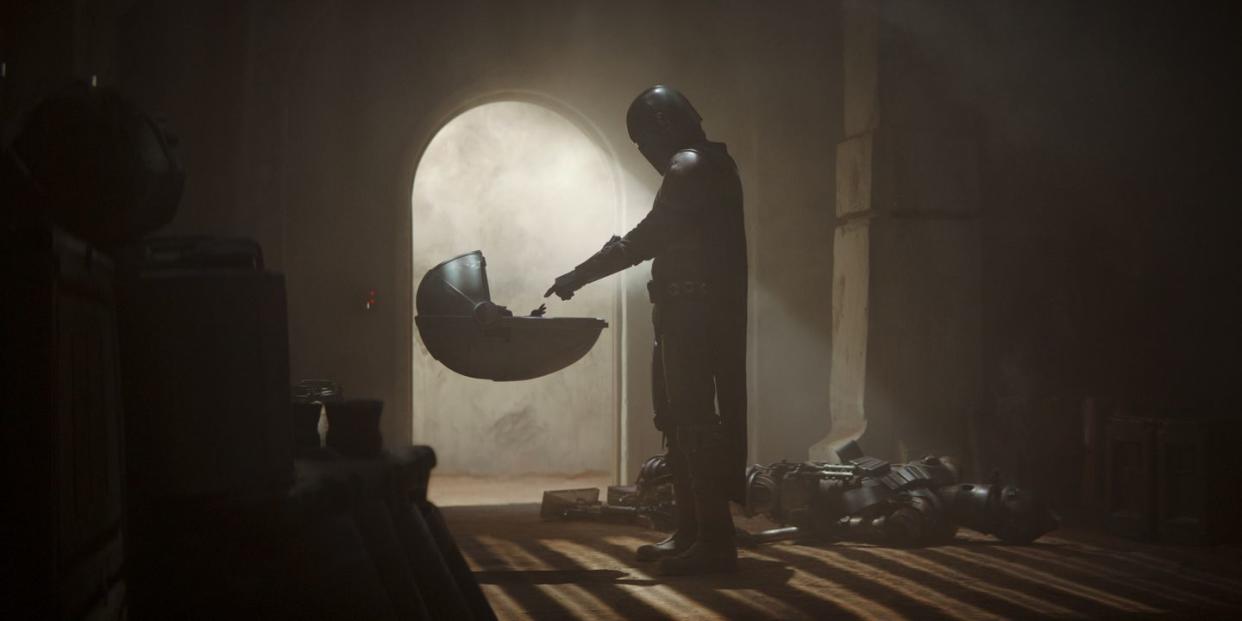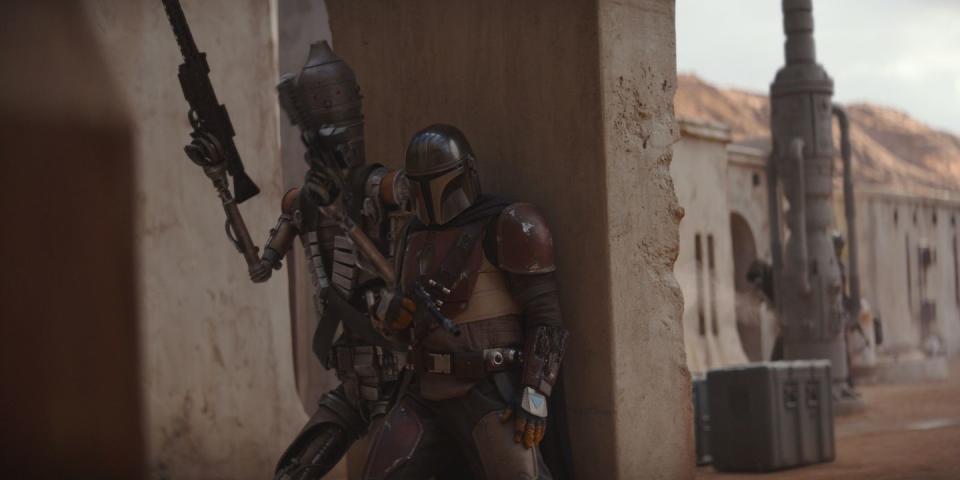'The Mandalorian' Is the Future of 'Star Wars'

It’s been five years since Star Wars returned in live-action fashion, and it’s certainly had its ups and downs. What began with The Force Awakens, a fresh yet pleasingly nostalgic exploration of the Skywalker story, expanded to include two somewhat controversial sequels in the legacy trilogy, a lackluster Han Solo outing, and an impressive jaunt for a rogue team of rebels on a mission to find the Death Star plans.
It’s this latter movie, Rogue One: A Star Wars Story, that paved the way for The Mandalorian. The first live-action TV show from Lucasfilm (if you don’t include the 1978 Star Wars Holiday Special) is similarly positioned against the backdrop of the Skywalker saga, but focuses on an array of new characters. However, while the events of Rogue One directly relate to the story of 1977's A New Hope and include such primary characters as Princess Leia and Darth Vader, The Mandalorian has its own narrative autonomy. The story exists on its own merit without being a plot device for the space opera’s overarching narrative, and that’s why it should serve as the blueprint for future Star Wars offerings.
Set five years after the fall of the Empire in Return of the Jedi and 25 years before The Force Awakens’ plot begins, The Mandalorian follows the titular gunfighter, played by Pedro Pascal, working in the outer reaches of the galaxy and purposefully far from the authority of the New Republic. As a multiethnic clan, the Mandalorians share a common creed and code, though the morals of this particular warrior are rather questionable, suiting his chosen path of bounty hunter. But when a new job leads him to The Child, he goes from hunter to prey as his protective instincts for the orphan kick in.
It’s this transition from selfish gunslinger to selfless single dad that’s refreshing to witness in a Star Wars story. You can’t move for daddy issues in George Lucas’ space opera, but The Mandalorian presents a less toxic version of the father-child relationship. Instead of following in the footsteps of absentee parents Darth Vader and Galen Erso, both of whom leave their children at a young age, show creator Jon Favreau takes his cues from Japanese manga Lone Wolf and Cubby, having Mando reluctantly take on the role of the caregiver. He slowly accepts his new fatherly responsibilities over the subsequent seven episodes, and since each installment is around 30 minutes long, we only see an idealized, heroic version of fatherhood that doesn’t dwell on the minutiae of child-rearing.
No one’s looking to Star Wars for a dose of reality, anyway; viewers want to see the wild wilderness of a galaxy far, far away, and through Mando and the kid (affectionately dubbed “Baby Yoda” because of his shared heritage with the iconic Jedi Master), we come into contact with a diverse range of droids, species, and alien races, plucked from the far reaches of the Star Wars Extended Universe as the two elude The Client (Werner Herzog) and the ominous forces he serves.
Favreau has admittedly designed The Mandalorian to be more of a space Western than space opera, and Emmy nominations in categories related to production design, cinematography, picture editing, and fantasy/sci-fi costumes serve as an early reward for this creative direction. There are major callbacks to Sergio Leone’s spaghetti Westerns as well as classics like The Searchers, Shane, The Magnificent Seven, and The Good, The Bad, and the Ugly. Rarely an episode goes by without a bar scene, bounty hunting, or deadly shoot-out. There’s even an episode called “The Gunslinger” set on Tatooine, the frontier-looking desert planet home of Obi-Wan Kenobi and Luke Skywalker, that sees the Mandalorian do a John Wayne in The Shootist. He takes young bounty hunter Toro Calican (Jake Cannavale) under his wing as they try to bring in outlaw assassin Fennic Shand (Ming Na Wen). Given how little the Western genre is represented in film and TV nowadays, it’s refreshing to see these vintage tropes applied so richly in the Star Wars Universe.
For decades, the franchise's live-action outings have been governed primarily by the creative voices of white men. Leigh Brackett is the only woman to get an actual writing credit for a Star Wars film (she co-wrote The Empire Strikes Back with Lawrence Kasden), and in 2017, Victoria Mahoney became the first Black filmmaker and woman hired in any sort of directing capacity on a Star Wars film by serving as JJ Abrams’ second unit director on The Rise of Skywalker. Onscreen, there’s been better representation for women and people of color in the years since Force Awakens, as Daisy Ridley, John Boyega and Oscar Isaac took center stage with the likes of Kelly Marie Tran, Donnie Yen, Riz Ahmed, Diego Luna, Lupita Nyong’o, Naomi Ackie and Thandie Newton to diversify the film franchise. But The Mandalorian has arguably managed to achieve more progress in the live-action universe, both in front of and behind the camera, through just one season.

With Pascal, a Chilean-American actor, in the lead, the series boasts Gina Carano, Nick Nolte, Giancarlo Esposito, Emily Swallow, Carl Weathers, Omid Abtahi, Taika Waititi, Ming-Na Wen, Julia Jones, and Natalia Tena in key roles. Esposito and Waititi now boast Emmy nominations for their guest actor and voiceover performances, respectively.
On the direction front, Bryce Dallas Howard and Deborah Chow were each invited to direct episodes alongside Famuyiwa, Waititi, and Dave Filoni because, as Favreau explains it, they are filmmakers who are “pushing the medium in a different way.” Interestingly, the showrunner especially praised Howard for directing Episode 4, “Sanctuary,” as she was a relative newcomer to that sort of filmmaking. “We threw you in the deep end of the pool,” Favreau told her in Disney+ docuseries Disney Gallery: Star Wars The Mandalorian. “That was such a difficult episode to do, and we were like, ‘We have got to pick the person who has never done this before because they won’t know how hard it is.’”
Just a few years earlier, Lucasfilm president Kathleen Kennedy had asserted that female directors couldn’t come into Star Wars “with essentially no experience.” Clearly, that sort of prejudice wasn’t present on The Mandalorian set. Rather, it was a place where filmmakers of different backgrounds—whether that be gender, racial, or, in Filoni’s case, professional (he hails from the world of animation)—were trusted and expected to put their own specific stamp on the Star Wars world. Now, the future of the big-screen franchise is looking better, with J.G. Dillard and Taika Waititi at the helm of two solo movies, (1917 co-writer Krysty Wilson-Cairns is teaming with the latter director to co-write his film), but it’s still a boys club that needs to make room for female directors like Chow and Howard, too.
The Mandalorian is more than proof that a Star Wars story doesn’t need to prop up the Skywalker narrative, come from white male filmmakers, or even be a film in order for it to earn acclaim. Its 15 Emmy nominations including Best Drama certainly testify to that. Audiences want variety. They want diversity reflected in character, plot, and filmmaking, and there are certainly enough stories in the Extended Universe to make each trip to a galaxy far, far away feel brand spanking new.
You Might Also Like

 Yahoo News
Yahoo News 
